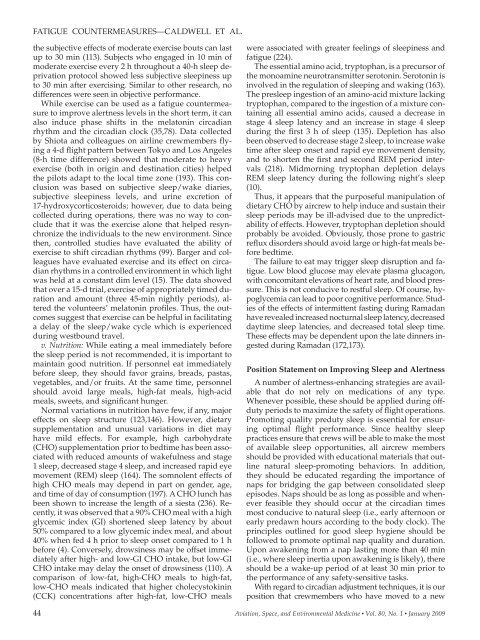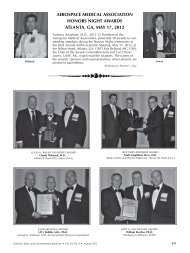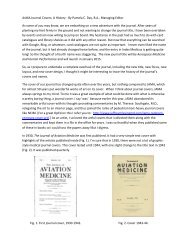Fatigue Countermeasures in Aviation - Aerospace Medical Association
Fatigue Countermeasures in Aviation - Aerospace Medical Association
Fatigue Countermeasures in Aviation - Aerospace Medical Association
You also want an ePaper? Increase the reach of your titles
YUMPU automatically turns print PDFs into web optimized ePapers that Google loves.
FATIGUE COUNTERMEASURES — CALDWELL ET AL.<br />
the subjective effects of moderate exercise bouts can last<br />
up to 30 m<strong>in</strong> ( 113 ). Subjects who engaged <strong>in</strong> 10 m<strong>in</strong> of<br />
moderate exercise every 2 h throughout a 40-h sleep deprivation<br />
protocol showed less subjective sleep<strong>in</strong>ess up<br />
to 30 m<strong>in</strong> after exercis<strong>in</strong>g. Similar to other research, no<br />
differences were seen <strong>in</strong> objective performance.<br />
While exercise can be used as a fatigue countermeasure<br />
to improve alertness levels <strong>in</strong> the short term, it can<br />
also <strong>in</strong>duce phase shifts <strong>in</strong> the melaton<strong>in</strong> circadian<br />
rhythm and the circadian clock ( 35 , 78 ). Data collected<br />
by Shiota and colleagues on airl<strong>in</strong>e crewmembers fly<strong>in</strong>g<br />
a 4-d flight pattern between Tokyo and Los Angeles<br />
(8-h time difference) showed that moderate to heavy<br />
exercise (both <strong>in</strong> orig<strong>in</strong> and dest<strong>in</strong>ation cities) helped<br />
the pilots adapt to the local time zone ( 193 ). This conclusion<br />
was based on subjective sleep/wake diaries,<br />
subjective sleep<strong>in</strong>ess levels, and ur<strong>in</strong>e excretion of<br />
17-hydroxycorticosteroids; however, due to data be<strong>in</strong>g<br />
collected dur<strong>in</strong>g operations, there was no way to conclude<br />
that it was the exercise alone that helped resynchronize<br />
the <strong>in</strong>dividuals to the new environment. S<strong>in</strong>ce<br />
then, controlled studies have evaluated the ability of<br />
exercise to shift circadian rhythms ( 99 ). Barger and colleagues<br />
have evaluated exercise and its effect on circadian<br />
rhythms <strong>in</strong> a controlled environment <strong>in</strong> which light<br />
was held at a constant dim level ( 15 ). The data showed<br />
that over a 15-d trial, exercise of appropriately timed duration<br />
and amount (three 45-m<strong>in</strong> nightly periods), altered<br />
the volunteers ’ melaton<strong>in</strong> profiles. Thus, the outcomes<br />
suggest that exercise can be helpful <strong>in</strong> facilitat<strong>in</strong>g<br />
a delay of the sleep/wake cycle which is experienced<br />
dur<strong>in</strong>g westbound travel.<br />
v. Nutrition: While eat<strong>in</strong>g a meal immediately before<br />
the sleep period is not recommended, it is important to<br />
ma<strong>in</strong>ta<strong>in</strong> good nutrition. If personnel eat immediately<br />
before sleep, they should favor gra<strong>in</strong>s, breads, pastas,<br />
vegetables, and/or fruits. At the same time, personnel<br />
should avoid large meals, high-fat meals, high-acid<br />
meals, sweets, and significant hunger.<br />
Normal variations <strong>in</strong> nutrition have few, if any, major<br />
effects on sleep structure ( 123 , 146 ). However, dietary<br />
supplementation and unusual variations <strong>in</strong> diet may<br />
have mild effects. For example, high carbohydrate<br />
(CHO) supplementation prior to bedtime has been associated<br />
with reduced amounts of wakefulness and stage<br />
1 sleep, decreased stage 4 sleep, and <strong>in</strong>creased rapid eye<br />
movement (REM) sleep ( 164 ). The somnolent effects of<br />
high CHO meals may depend <strong>in</strong> part on gender, age,<br />
and time of day of consumption ( 197 ). A CHO lunch has<br />
been shown to <strong>in</strong>crease the length of a siesta ( 236 ). Recently,<br />
it was observed that a 90% CHO meal with a high<br />
glycemic <strong>in</strong>dex (GI) shortened sleep latency by about<br />
50% compared to a low glycemic <strong>in</strong>dex meal, and about<br />
40% when fed 4 h prior to sleep onset compared to 1 h<br />
before ( 4 ). Conversely, drows<strong>in</strong>ess may be offset immediately<br />
after high- and low-GI CHO <strong>in</strong>take, but low-GI<br />
CHO <strong>in</strong>take may delay the onset of drows<strong>in</strong>ess ( 110 ). A<br />
comparison of low-fat, high-CHO meals to high-fat,<br />
low-CHO meals <strong>in</strong>dicated that higher cholecystok<strong>in</strong><strong>in</strong><br />
(CCK) concentrations after high-fat, low-CHO meals<br />
were associated with greater feel<strong>in</strong>gs of sleep<strong>in</strong>ess and<br />
fatigue ( 224 ).<br />
The essential am<strong>in</strong>o acid, tryptophan, is a precursor of<br />
the monoam<strong>in</strong>e neurotransmitter seroton<strong>in</strong>. Seroton<strong>in</strong> is<br />
<strong>in</strong>volved <strong>in</strong> the regulation of sleep<strong>in</strong>g and wak<strong>in</strong>g ( 163 ).<br />
The presleep <strong>in</strong>gestion of an am<strong>in</strong>o-acid mixture lack<strong>in</strong>g<br />
tryptophan, compared to the <strong>in</strong>gestion of a mixture conta<strong>in</strong><strong>in</strong>g<br />
all essential am<strong>in</strong>o acids, caused a decrease <strong>in</strong><br />
stage 4 sleep latency and an <strong>in</strong>crease <strong>in</strong> stage 4 sleep<br />
dur<strong>in</strong>g the first 3 h of sleep ( 135 ). Depletion has also<br />
been observed to decrease stage 2 sleep, to <strong>in</strong>crease wake<br />
time after sleep onset and rapid eye movement density,<br />
and to shorten the first and second REM period <strong>in</strong>tervals<br />
( 218 ). Midmorn<strong>in</strong>g tryptophan depletion delays<br />
REM sleep latency dur<strong>in</strong>g the follow<strong>in</strong>g night’s sleep<br />
( 10 ).<br />
Thus, it appears that the purposeful manipulation of<br />
dietary CHO by aircrew to help <strong>in</strong>duce and susta<strong>in</strong> their<br />
sleep periods may be ill-advised due to the unpredictability<br />
of effects. However, tryptophan depletion should<br />
probably be avoided. Obviously, those prone to gastric<br />
reflux disorders should avoid large or high-fat meals before<br />
bedtime.<br />
The failure to eat may trigger sleep disruption and fatigue.<br />
Low blood glucose may elevate plasma glucagon,<br />
with concomitant elevations of heart rate, and blood pressure.<br />
This is not conducive to restful sleep. Of course, hypoglycemia<br />
can lead to poor cognitive performance. Studies<br />
of the effects of <strong>in</strong>termittent fast<strong>in</strong>g dur<strong>in</strong>g Ramadan<br />
have revealed <strong>in</strong>creased nocturnal sleep latency, decreased<br />
daytime sleep latencies, and decreased total sleep time.<br />
These effects may be dependent upon the late d<strong>in</strong>ners <strong>in</strong>gested<br />
dur<strong>in</strong>g Ramadan ( 172 , 173 ).<br />
Position Statement on Improv<strong>in</strong>g Sleep and Alertness<br />
A number of alertness-enhanc<strong>in</strong>g strategies are available<br />
that do not rely on medications of any type.<br />
Whenever possible, these should be applied dur<strong>in</strong>g offduty<br />
periods to maximize the safety of flight operations.<br />
Promot<strong>in</strong>g quality preduty sleep is essential for ensur<strong>in</strong>g<br />
optimal flight performance. S<strong>in</strong>ce healthy sleep<br />
practices ensure that crews will be able to make the most<br />
of available sleep opportunities, all aircrew members<br />
should be provided with educational materials that outl<strong>in</strong>e<br />
natural sleep-promot<strong>in</strong>g behaviors. In addition,<br />
they should be educated regard<strong>in</strong>g the importance of<br />
naps for bridg<strong>in</strong>g the gap between consolidated sleep<br />
episodes. Naps should be as long as possible and whenever<br />
feasible they should occur at the circadian times<br />
most conducive to natural sleep (i.e., early afternoon or<br />
early predawn hours accord<strong>in</strong>g to the body clock). The<br />
pr<strong>in</strong>ciples outl<strong>in</strong>ed for good sleep hygiene should be<br />
followed to promote optimal nap quality and duration.<br />
Upon awaken<strong>in</strong>g from a nap last<strong>in</strong>g more than 40 m<strong>in</strong><br />
(i.e., where sleep <strong>in</strong>ertia upon awaken<strong>in</strong>g is likely), there<br />
should be a wake-up period of at least 30 m<strong>in</strong> prior to<br />
the performance of any safety-sensitive tasks.<br />
With regard to circadian adjustment techniques, it is our<br />
position that crewmembers who have moved to a new<br />
44 <strong>Aviation</strong>, Space, and Environmental Medic<strong>in</strong>e x Vol. 80, No. 1 x January 2009





